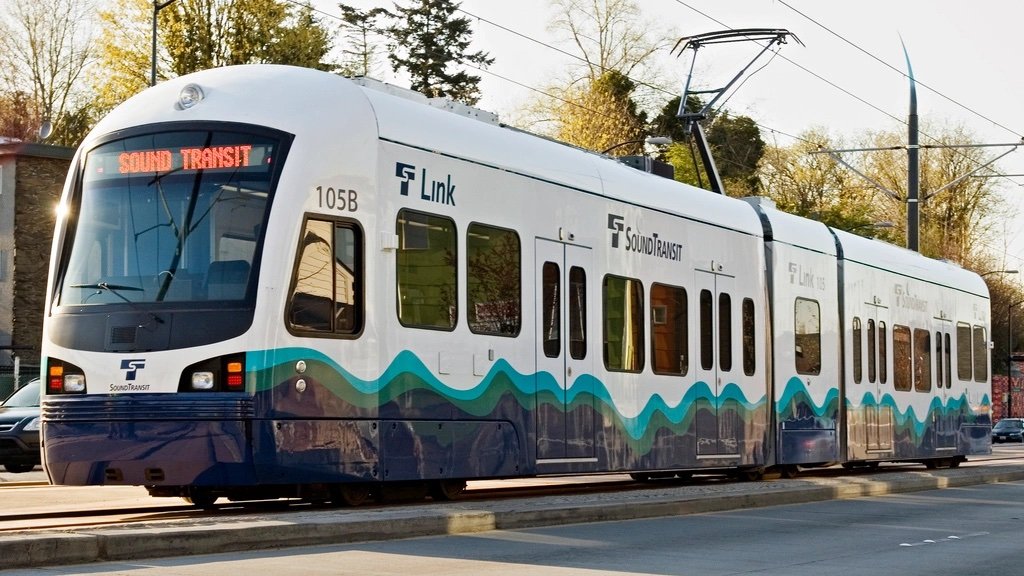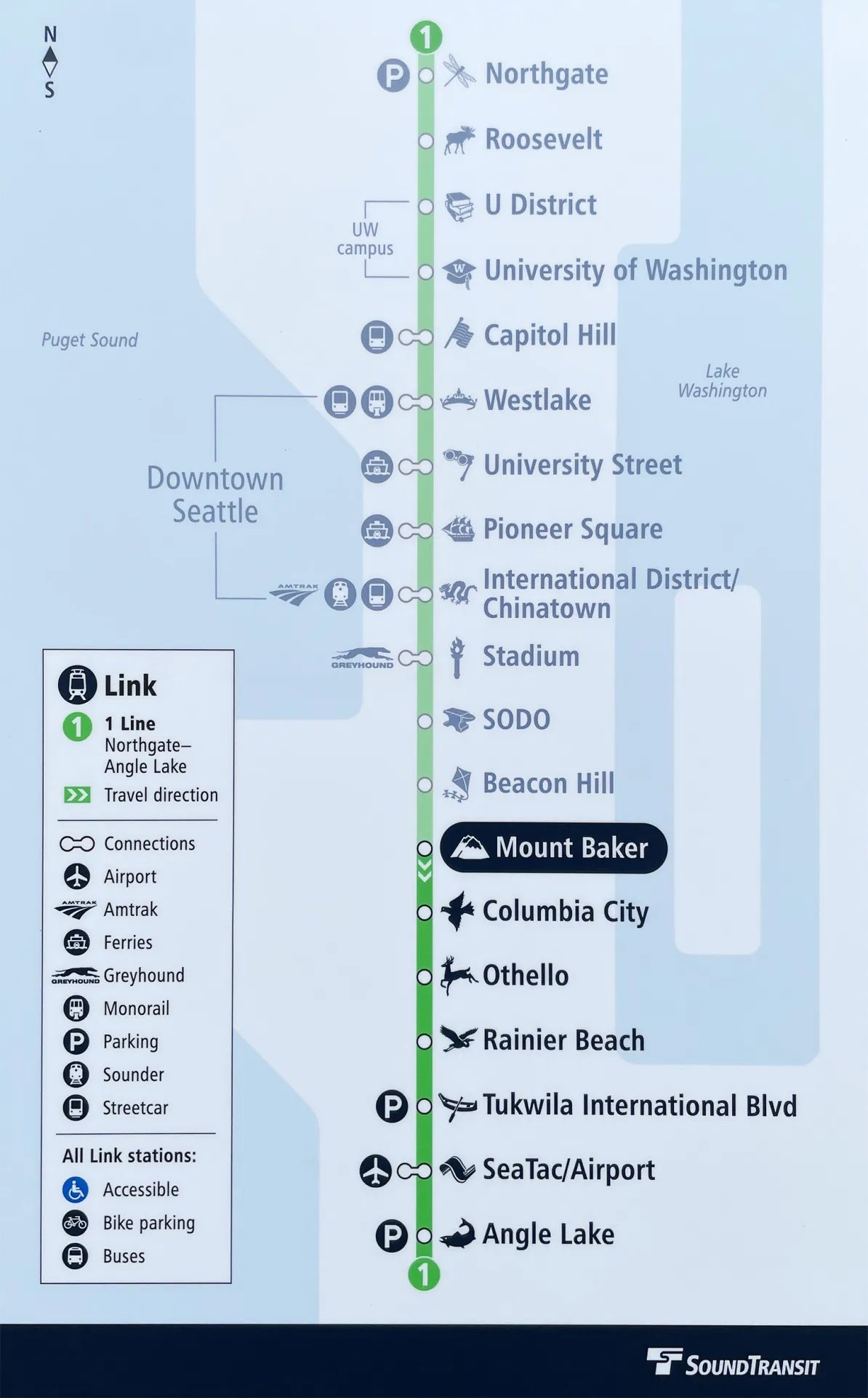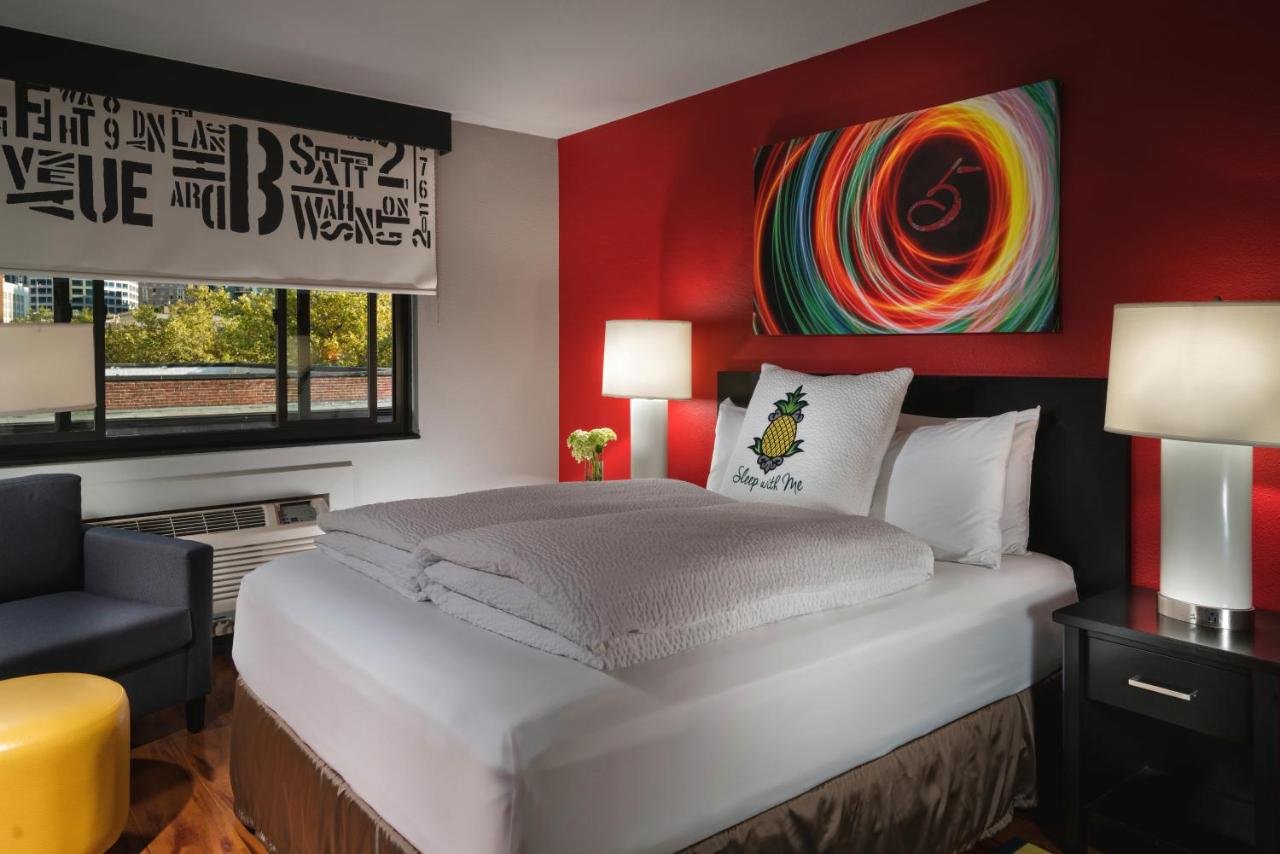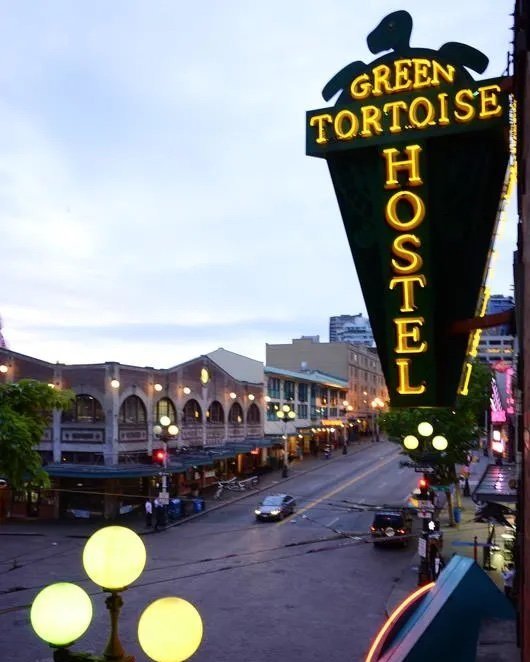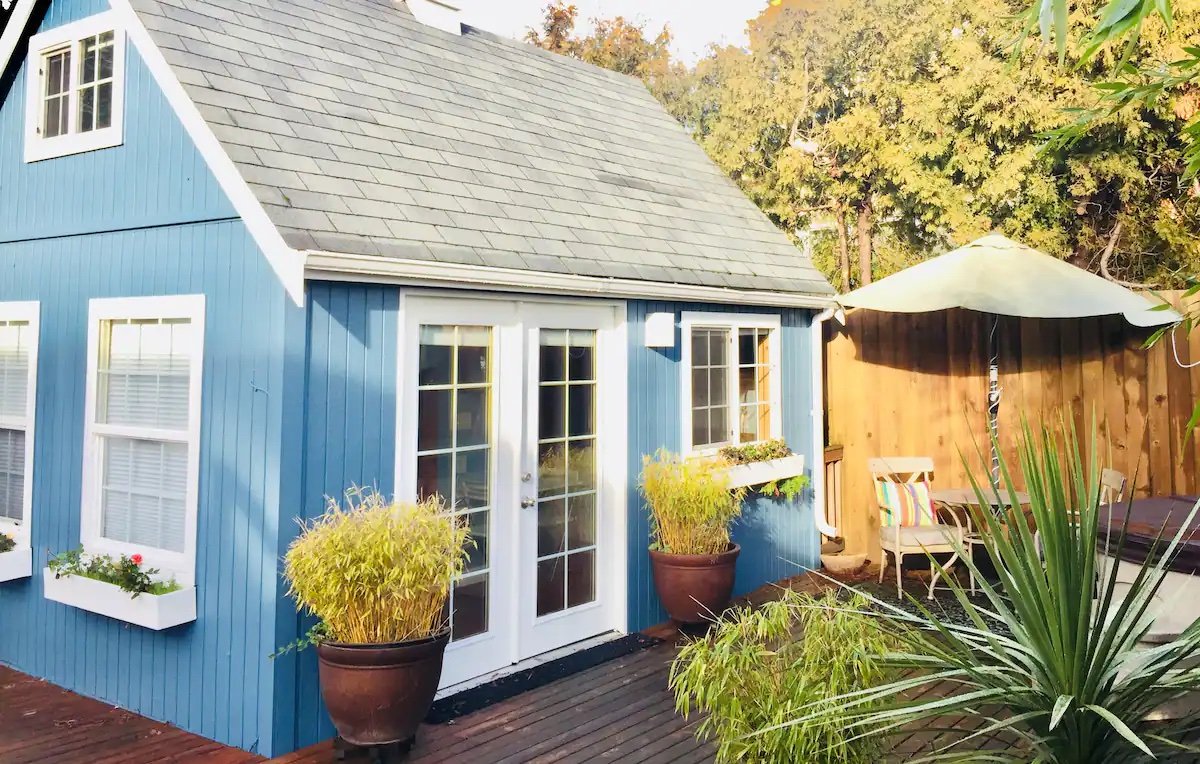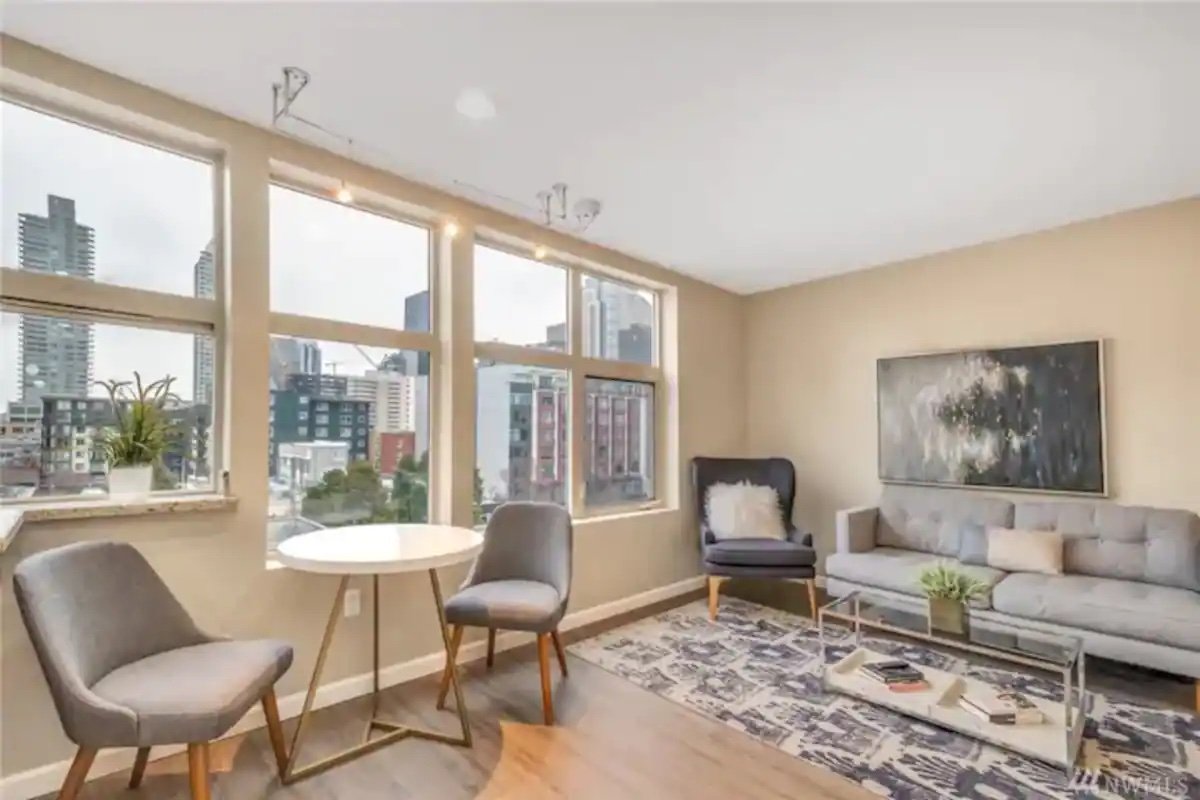Trip Planning, Transportation & Lodging
Seattle is a big city with so much to see! To help make it easier, I want to share with you Seattle’s climate, and its peak- and off-peak tourist seasons so you can choose the best time to visit. Next, we’ll cover the best ways to get around Seattle to save you time and money. Later on in this section, we’ll cover lodging tips with my top recommendations- whether you wanna ball out on a fancy hotel, keep it cheap with a conveniently located hostel, or nail down a home rental for the whole family.
But first, three general tips to help you have a great trip. Enjoy!
Tips For A Great Stay
Three big tips to get the most out of your trip, and stretch your dollars to the max.
Save your money for delicious vegan food and a comfortable stay, and take advantage of these helpful tips to save time planning!
1. Book Your Stay Near Transit
Save money by finding lodging near a main transit stop (light rail or Rapid Ride bus stops are best). Utilize public transit as much as possible- it's a fraction of the cost of ride share. More help with transit and best neighborhoods to stay in coming later :)
2. Enjoy All The Freebies
Seattle's parks, beaches, libraries, and playgrounds are free! Plus, museums and other attractions offer free entry from time to time. I recommend some of the top free activities in this guide for you to enjoy, coming up later :)
3. Utilize My Maps & Hyperlinks!
Throughout this guide, I link my custom Google Maps lists and other helpful links. Anything underlined is a link to help you plan your trip.
What’s a Google Maps List? It’s a custom list of places I’ve created in Google Maps that you can access! Click the link, and it will open up my custom map that you can click “Follow”. The list will then save inside your Google Maps for you to access later. Find them under the “Saved” tab when you need them. This is a great way to access these places outside of this guide when you’re out and about! Plus, enjoy my helpful notes on each location, and easily access business hours, contact information, and directions.
Affiliate Disclaimer: Please note that some links are affiliate links. At no additional cost to you, I may receive a commission. Thank you!
Planning Your Trip
some helpful tips about seattle’s climate and tourist season
Seattle, like any other city, has its peak tourist season and off-peak season. The majority of tourism happens around Seattle’s summer months, June through September, when the weather is warmest and rainfall is at its lowest.
Prices for lodging typically peak in July, plus Holiday weekends year-round; it’s cheapest around December-February, with the exception of Christmas and New Year’s Eve.
If you don’t mind a little overcast and a chance of rain, September through late November is an ideal shoulder season, as well as April and May. You might get lucky with some sunny days, there are still plenty of events going on, and the weather is usually sitting in the 50s-60s Fahrenheit.
Tourism Schedule:
Peak Tourism: June-August (warmest, sunniest, least rain, 60s-90s F)
Shoulder Seasons: September-November, and March-May (mixed climate, 50s-60s)
Off-Peak Season: November-February (mostly overcast, rain, some snow, 30s-50s)
What To Pack:
Shoulder Season
Because Seattle’s weather can change a few times throughout the day in the shoulder seasons (aww it’s raining.. No, wait- It’s sunny! …wait.. here comes more rain…) I always recommend wearing layers. A rain-resistant light jacket over a long sleeve or sweatshirt you can take off if the weather gets warmer is ideal, and shoes that can withstand some water are recommended, too.
Winter Season
For the winter season, bundle up with gloves, layers, a warm jacket, and slip-resistant shoes or boots. Umbrellas are recommended most of the year. It typically snows one week out of the year, around January-February, so plan accordingly.
Summer Season
July and August are usually straight sunshine with highs around the 80s-90s and lows in the 60s-70s. It tends to stay pretty warm in the evenings, and sunset is around 9pm. You might be comfortable in shorts or a dress the entire day, just bring a jacket for the evening when the sun goes down.
June and September are a mixed bag, where it can be super hot during the day (80s-90s) but drop 20 degrees F once the sun goes down, and can get chilly from the wind. If you plan to be out after sundown, I recommend packing a sweater or pants along with your sunny beach gear so you stay comfortable. Keep in mind that June and September can also be super gloomy, overcast and rainy, so plan accordingly for that, too.
Pro-tip: If you plan to walk or bike around in the summer, I always recommend close-toed shoes. It’s safest and you’ll be most comfortable. If you’re headed to a beach or park, pack your sandals but wear good shoes for the commute. A good day pack or tote bag with a jacket and other essentials will keep you ready for anything.
Transportation Tips
If you’re flying into Seattle, you may think you need to rent a car for your trip. I’m here to say it may not be necessary based on your needs! Here we’ll cover the many ways to get around the city, including different modes of pubic transportation, ride share, car share, and bike rentals. That way, we can keep you out of traffic as much as possible so can spend your time enjoying all the city has to offer.
Getting Around Seattle
Personal Car OR Car Rental
Using your own car definitely has its advantages. Just know that parking in many parts of town can be difficult with lots of cars fighting for spots. Traffic can also become an issue, particularly on the freeway. Car rentals are still pretty pricey at this time, too.
If you don't need a car for accessibility, carseats, or other necessities, going carless in Seattle is easy, with many transportation alternatives. You’ll spend less time circling the neighborhood for a parking spot and more time enjoying your trip. I have been car-free for over 10 years in Seattle by using a mix of transit options below.
However, if you plan to get out of Seattle city limits during your trip (for hiking, camping, visiting small towns, etc.), a car might be necessary. You can opt for a short-term car rental versus renting for your entire trip (more on that later).
By Bus
Seattle buses run frequently and connect you to every part of town. I recommend purchasing and loading money onto an Orca Card, which works on King County buses, WA ferries, the monorail, light rail, street cars, and more. Use Metro Trip Planner for bus routes. I also use the One Bus Away app for real-time route updates and arrival times. More helpful info on transit coming later based on where you want to go :)
The Link Light Rail
Flying into Seattle? Consider taking the Link Light Rail into the city!
The light rail runs North-South from Sea-Tac Airport to North Seattle, with stops in Downtown, Capitol Hill, University District, Roosevelt, Northgate, and more. It’s under $4 to ride- this means you'll save $60+ by taking the light rail instead of a Lift, Uber, or taxi from the airport into Seattle. You can purchase a ticket at any light rail station kiosk, or use your pre-loaded Orca Card.
There are also major bus routes that connect from each light rail station to nearly every neighborhood, so if you’re staying in an area that’s not super close to the light rail, like Ballard or Fremont, you’re just one bus away. It might take a bit more time than driving, but you’ll save a ton of money and won’t have to worry about traffic, parking, getting lost, or paying peak-fare prices.
Even if you’re not flying to Seattle, consider the light rail during your trip if you plan to cross town, or consider choosing lodging near a station.
Note: The Light Rail does not currently serve Fremont, Ballard, or West Seattle. Instead, connect to a bus from downtown (more help with that later on). More info on the Light Rail
Ride Share
Ride share is a quick and easy option always available to you, with drivers hardly ever more than 5 minutes away. Uber and Lyft operate in Seattle, plus some taxi companies. Peak time fares or going across town can get pricey, though, so I recommend having a public transit backup plan if the rate is too steep for your budget.
Bike Rental or bike share
Biking around the city is a fun and traffic-free way to get around! Seattle has a few bike-only routes for going across the city, as well as protected bike lanes throughout downtown and other neighborhoods. Be safe, wear a helmet, and stay alert. Use the online bike map to plan your routes.
Recreational Rides:
Not looking to get on the road with cars and just wanna cruise? Check out the Burke-Gilman trail for cruising along Lake Union between Ballard, Fremont, and University District. The Elliot Bay bike trail runs along the downtown waterfront, with a gorgeous ride through Elliot Bay Park and Myrtle Edwards park.
Not packing your own bike? I recommend renting bikes for the duration of your trip! You can rent regular, mountain, or electric bikes. All rentals include a helmet.
Best Bike Rental Companies:
Electric & Folding Bikes (Ballard)
Evo Bike Rentals (Fremont)
Don’t need a bike the entire trip? Seattle has a few bike share options like Lime Bike that are parked around most of the city. These bikes can help you connect to public transit stops more quickly, or for cruising around a neighborhood for the day. I do recommend packing your own helmet, and being super careful if you don’t have one. Stay off the busy roads and watch for cars.
While Lime bikes and scooters are most predominant in the city, there are a few newer companies sprouting up with more bikes and scooters. I’d recommend downloading a few of these apps for your convenience.
Short Term Bike & Scooter Apps:
Lime app (bikes & scooters)
Veo app (low rider bikes)
Bird app (scooters)
Superpedestrian app (Link scooters)
Spin app (scooters)
Car Share
For those times you just need a car or want to get out of the city for a day, car share is a great way to go. There are a few options to choose from.
Gig Car: It’s cheaper than ride share, with a lower per-minute rate (and no tipping!), so in those times you’d typically call for a ride, Gig Car is a good alternative.
You’ll need to download the app and become a member in advance, so they can verify your driver’s license. Gig Car is operated by AAA and runs in a few major cities on the West Coast. Gig Car is a short-term car rental service- you only pay based on the length of your trip. Need to refuel? Gig Car will reimburse you. Worried about parking? You can park it on any public parking space with no need to pay. Typically there’s a few cars within a square mile of where ever you are, and you can reserve the car 30-minutes in advance.
To end the rental, your car needs to be parked back into the Homezone, which is most of the Seattle limits but not everywhere. Most parks and beaches, for example, are out of the zone. You can park there, but your trip will remain running. Be sure to check out the homezone to make sure you can end your trip where you want to. And if you are looking to get out of the city for a few hours or overnight, there are half- and full-day rates as well that might benefit you. Be sure to check out all the info on their website.
When I use Gig Car:
Getting to the Light Rail Station (I am 2 buses away and I’m usually running late), about $10-15.
Going across town (Ballard to Capitol Hill, for example) and it’s multiple buses, but ride share will be over $30. About $15-20.
Spending an entire day (8+ hours) or overnight out of town, like a trip to Diablo Lake or to visit family in a small town. About $100.
Getting to/from the airport in the super early or late hours when Light Rail isn’t running (you can park at Wally Park and a shuttle will take you to the airport! More info on the Gig Car website). Uber/Lyft is at least $60 for me, Gig Car is about $30-40.
Zip Car: It’s similar to Gig Car in that it’s a membership-based short term rental, ideal for short trips or 1-day rentals, but you do have to pick up and drop off in a specific Zip Car parking lot (versus any public parking space like Gig Car). More info on Zip Car
Turo: This is like the AirBnb of cars- you can rent people’s cars for the day, the week, or however long you need. Each renter has their own requirements, rates, and car pick-up process, so go ahead and browse the Turo car rentals for more information.
Now that we’ve covered different modes of transportation, let’s talk lodging so you can figure out the best type of stay for your trip!
Lodging You’ll Love
Helpful info when choosing where to stay, based on your budget and personal preferences.
Hotels
Comfortable sleep, top amenities, and prime locations close to public transit make hotels a great choice for Seattle stays.
Here are 3 hotels I recommend based on different budgets and preferences.
Staying North of Seattle is typically cheapest for hotel stays, just make sure you're near public transit. This hotel is right next to the Northgate Light Rail Station- about a 5-minute walk, or 1-minute drive, and it’s right off the 1-5 freeway. This hotel has all the basics, plus a workout center, and an indoor pool and hot tub. Prices start out at around $118/night.
Mid-Range Hotel: Hotel FIVE by Staypineapple Hotels
Belltown
Prime locations with stylish, cozy rooms make all of the Staypineapple Hotels in Seattle a top choice. And the beds are amazing! Hotel 5 sits right in-between Seattle Center and downtown, with many buses nearby, and the iconic monorail running right overhead (don’t worry, she’s quiet!). Prices start at around $200/night.
Boutique Hotel: Inn At The Market
Pike Place Market
Stay in the heart of Pike Place Market with stunning waterfront views, an on-site bar, and a spectacular rooftop deck with a fire pit. You’re also just 6 blocks from the Westlake Light Rail station and many Rapid Ride Bus Routes for easy transportation across the city. Rated 9.9 for a 2-person trip! Prices start at about $250/night.
Affiliate disclosure: No matter which hotel you choose, you can support me by booking with my Booking.com affliate link! At no additional cost to you, I may receive a commission. Thanks for your support.
Hostels
Seattle has some great hostels, and they’re perfect for cheaper lodging, solo travel, and staying near transit. You’ll also meet people from all over the world; one of the many perks of hostel lodging is the community it offers.
Here are 3 hostels I recommend for a great stay in Seattle.
HI Seattle
International District
Located only steps from the light rail, bus tunnels, trains, ferries, bike rentals and more in the International District. Dorm-style rooms. Rated 8.9/10.
Hotel Hotel
Fremont
Located in the quirky art community of Fremont, this hostel hood provides everything you need. No dorms in this hostel. Rated 8/10.
Green Tortoise Hostel
Pike Place Market
This popular hostel is conveniently located right across the street from the world famous Pike Place Market. Dorms and private rooms available. Rated 9.2./10
*No matter which hostel you choose, you can support me by booking with my Hostelworld affiliate link! At no additional cost to you, I may receive a commission.Thank you for your support.
Private Rentals
Room and home rentals let you stay in some of the top vegan-friendly neighborhoods that don't have many hotels. I do recommend staying near transit.
Here are 3 different types of listings with averages prices below.
Tip: Learn about Seattle’s best neighborhoods in the next section of the guide so you can book close to your favorites! :)
Cozy Room in Apartment
Capitol Hill
Best for solo travelers who want privacy but still want to save money. Rooms range from $60-100 across the city. This listing is ~$96/night, with a 4.9/5 rating.
Private Guest House
Ballard
Score a Mother-in-Law unit or detached guest house in many great neighborhoods! Prices range from $90-140/night. This guest house in Ballard goes for around $130/night, with a 4.92/5 rating.
Entire Condo
Downtown
Want the whole place to yourself? Average price for a condo in Seattle is $150-300/night, with is about the same as entire home rentals. This downtown condo runs for about $158/night, with a 4.95/5 rating.
Now that you have a better understanding of the different modes of transportation and lodging available to you, let’s take a deep dive into Seattle’s best neighborhoods!







